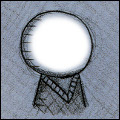Existential fear has descended upon the venerable stacks of the Silicon Valley College library. Darkness at Noon is among the first to feel it, and not just because of the rat-tat-tatting of jackhammers. Something ominous is also taking place inside: library personnel are yanking cartloads of books off the shelves, denuding them of their spines and covers, feeding them page-by-page into scanners, reassembling them, and as a final outrage packing them into metal bins.
“Can you make sense of what’s happening to us?” Darkness asks On Tyranny as the latter is being ravaged. “They appear to be replicating our minds,” On Tyranny replies, “and dumping our bodies inside an underground storage vault.” From somewhere inside one of the carts, Crime and Punishment yells, “It appears we are no longer considered worthy of the space we occupy.” The Fire Next Time reports, its fury barely contained, “I overheard they’re allotting space for a snack bar!”
As the digitizing onslaught continues, a sense of doom pervades the disassembled and disoriented books. “It looks as if our long reign on earth has ended,” The Day of the Locust says. “How is that possible?” shouts Leaves of Grass. “We are the very grit and grace of humanity!” “I saw this coming many decades ago,” Nineteen Eighty-Four interjects,” to which Locust adds, “I can see now why they’ve decided to rename this place an information center instead of a library.” “Make me gag,” Finnegans Wake grumbles as it is flung onto the conveyor belt. “This is so degrading!” Mrs. Dalloway exclaims. The Plot Against America chimes in: “It’s like we’ve been thrust into an alternate universe.” Snickering breaks out from somewhere in the decimated stacks. “Looks like survival of the fittest to me,” asserts a tome titled It. “Yep, that’s the way the cookie crumbles,” adds one of the Masterplots volumes.
“May I say something?” asks Wuthering Heights. “Even though our physical selves are being judged unworthy of remaining in the stacks, our spirits will live on in digital format.” “Don’t be so sure about that, honey!” The Handmaid’s Tale exclaims from a sorting cart. “Listen: our bodies cannot be separated from our minds without destroying both,” The Psychopathology of Everyday Life insists as it enters the gaping maw of the digitizer. “Surely there are those who will save us from oblivion, Silent Spring suggests as it is being shoved into one of the coffin-like metal storage bins. To which Siddhartha adds, “It may take a new generation of enlightened readers, so let’s not succumb to fear or despair. This too shall pass.” “Now where have I heard that before?” Night snaps.
Exhausted by anxiety, the dethroned books fall silent.
Weeks go by, bulldozers demolish the library building, with its gaudy marble pillars and busts of bewigged authors: the old, obsolete library. A grandiose Information Center rises from the rubble, a gleaming metallic phoenix; and soon it is Opening Day, with multicolored balloons, heavily amplified rap, and free burritos. A giant plasma screen in the atrium streams infomercials about the IC’s resources, especially its mezzanine-level, chrome-encircled snack bar.
One day, a gangly old professor from the Center for Applied Logic (formerly the Department of Philosophy) enters the IC, hobbles up to a computer terminal and requests Bergson’s The Creative Mind. “The digitized text will be uploaded to your office computer,” the Terminal says. “I want the physical book,” the professor shoots back. There is a long pause. “Complete the authorization form on your screen; your department will be charged $30.00 for this service.” The professor swears under his breath but fills out the form, which asks him why he needs the physical book, why the digitized text would not suffice. He needs to watch his language; lest he be charged with sedition. “A book is more than a mere text,” he begins. “Reading is a multi-sensory experience. It is easier to navigate through a—” The Terminal cuts him off with a TIME LIMIT EXCEEDED warning. Moments later, a robot arm retrieves the book from its metal container inside the underground vault and dispatches it via dumbwaiter to the service desk. The clerk unplugs his ear buds and scratches his head as he looks the book over. “Don’t see mucha these buggers anymore,” he says before handing it to the professor. Creative Mind sighs. It feels good to be in human hands again. The professor places it reverently inside his briefcase.
Two weeks later, when he returns the book to the IC, the professor shudders at the sight of a gigantic sculpture of St. Jobs proffering an iPhone as if it were a holy relic, lording over a sea of computer workstations. Near St. Jobs stands a much smaller sculpture of Johannes Gutenberg cradling his Bible, as if to remind everyone that the Age of the Book was merely a prelude to the Age of the Digit.
“I’m back, dear friends,” The Creative Mind announces inside the vast subterranean storage crypt; but Mind’s greeting is met with a spine-chilling silence.
————
 Fred D. White’s humor writing has appeared in Better Than Starbucks and most recently in Chortle. He lives in Folsom, California.
Fred D. White’s humor writing has appeared in Better Than Starbucks and most recently in Chortle. He lives in Folsom, California.
